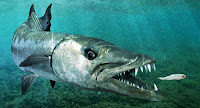I was watching a quiz show on television (probably Jeopardy) and one of the questions referred to the collective group name for a bunch of crows. My first thought was that I knew the answer…a murder of crows. My immediate second thought was just who decided that a bunch of crows would be referred to as a murder of crows.
We've all used the commonly known term of herd when referring to a group of cattle or horses or buffalo. Different groups of animals are collectively referred to by specific designations. And many of those collective group names make us scratch our heads and wonder who decided they would be called that and why.
So, my curiosity got to me and I did a little digging into collective group names for various animals.
Here's a cross section of some I found particularly interesting…and strange.
Alligators? They congregate in a congregation. However, crocodiles group together in a bask or a float. And rattlesnakes are a rhumba.
Barracudas are referred to as a battery (seems more appropriate for a group of electric eels). Jellyfish group together in a smack. And sharks form into a shiver (a name that seems very appropriate and properly descriptive).
Buzzards bunch into a wake.
Although both birds of prey, buzzards and vultures are not interchangeable
names for the same bird. Eagles form a convocation
or an aerie. A group of owls is a parliament or a stare. Ravens form an unkindness
or a storytelling (shades of Edgar
Allen Poe). And swallows give us a flight
or gulp (which seems to fit with
swallow).
Cats…as a general collective they can be a clowder or clutter or pounce or dout or nuisance or glorying or a
glare. Wild cats specifically form
into a destruction (not to be
confused with a pride of lions).
Giraffes group into a tower
(seems very appropriate).
Gnus are an implausibility
(seems only right for an animal that starts with a silent letter).
Porcupines come in a prickle
(again, an appropriately named collective).
Wolves, in general, group into a pack. However, if the wolves are moving they are known as a route or rout.
Zebras are known as a zeal
or crossing or dazzle or cohorts in
addition to the traditional herd.
And in the rodent community…we have ferrets grouped into a business. Squirrels are known as a dray or scurry.
But what about people, you might be asking. Well, here's someone's suggestion that might be appropriate: a nag of wives and a jerk of husbands. :)






































